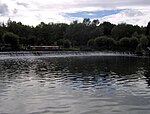University of Bristol Boat Club
Rowing club stubsRowing clubs in EnglandRowing clubs of the River AvonSport in Bristol

University of Bristol Boat Club is a rowing club on the River Avon based at the Saltford Rowing Centre, Bath Road, Saltford, Bristol.
Excerpt from the Wikipedia article University of Bristol Boat Club (License: CC BY-SA 3.0, Authors, Images).University of Bristol Boat Club
Bristol & Bath Railway Path,
Geographical coordinates (GPS) Address Website Nearby Places Show on map
Geographical coordinates (GPS)
| Latitude | Longitude |
|---|---|
| N 51.398521 ° | E -2.447412 ° |
Address
University of Bristol Boat House
Bristol & Bath Railway Path
BA1 9AE
England, United Kingdom
Open on Google Maps









